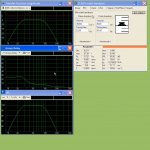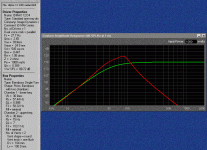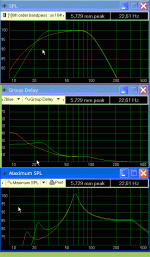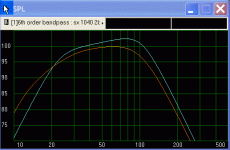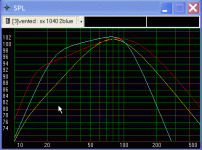Hi guys,
I just played around with WinISD pro to simulate 6th order bandpass subwoofer for in car use. Please have a look for driver spec, box volume and result graphs below.
I put system input power =40w and series resistance= 1 ohm.
I add lowpass (butterworth, n=2, fc=120Hz).
The SPL graph looks so good, but I rather worried with group delay (27,595ms at 23,31Hz).
Do you see any flaws with this sim result? can I get a better sim result than this?
I'm waiting for your comment before I start wood working.
Thankyou in advance for your help.
Chris.
I just played around with WinISD pro to simulate 6th order bandpass subwoofer for in car use. Please have a look for driver spec, box volume and result graphs below.
I put system input power =40w and series resistance= 1 ohm.
I add lowpass (butterworth, n=2, fc=120Hz).
The SPL graph looks so good, but I rather worried with group delay (27,595ms at 23,31Hz).
Do you see any flaws with this sim result? can I get a better sim result than this?
I'm waiting for your comment before I start wood working.
Thankyou in advance for your help.
Chris.
Attachments
I agree, adjust the enclosure so instead of the bandpass having a flat top shape it slopes up with increasing frequency, the attachment shows this more clearly, red is the bandpass curve while green is sealed.
The rising response blends in with the cabin better and the high tuning of the second chamber (70hz-80hz is common) reduces group delay and increases efficiency.
I've used this style of response curve for almost every BP enclosure ever since I discovered it.
The rising response blends in with the cabin better and the high tuning of the second chamber (70hz-80hz is common) reduces group delay and increases efficiency.
I've used this style of response curve for almost every BP enclosure ever since I discovered it.
Attachments
Hi Cro Maniac and Volenti,
thank's for your quick response.
I followed your suggestion and did a sim as you can see below.
rear chamber tuned to 16Hz.
front chamber not change = 63Hz.
green line = original sim.
yellow line= improved sim.
SPL (40w input power) @30Hz decrease -3dB from the original sim, is it enough to flatten in car SPL response?
Group delay also looks better (22ms @20Hz) it's OK or not?
But I rather confuse with Maximum SPL graph, it shows that max SPL at 63Hz (101dB), does it mean I will get big thumb at 63Hz and hear very weak sound below and above this peak?
Does SPL graph show real behaviour of the sub (minus room gain)?
thank's
Chris.
thank's for your quick response.
I followed your suggestion and did a sim as you can see below.
rear chamber tuned to 16Hz.
front chamber not change = 63Hz.
green line = original sim.
yellow line= improved sim.
SPL (40w input power) @30Hz decrease -3dB from the original sim, is it enough to flatten in car SPL response?
Group delay also looks better (22ms @20Hz) it's OK or not?
But I rather confuse with Maximum SPL graph, it shows that max SPL at 63Hz (101dB), does it mean I will get big thumb at 63Hz and hear very weak sound below and above this peak?
Does SPL graph show real behaviour of the sub (minus room gain)?
thank's
Chris.
Attachments
The last curve is about as good as it can get with that box. The curve should be more steeper to match car cabin gain properly, but now you wont have such a huge peak.
I see a problem in tryng to fit such a long port in 45liter rear chamber.
You should not worry about that. That graph only shows that if you intend tu play frequencies (not music) through this sub (SPL competition), you should get maximum result at 63Hz because port tuning reduces cone excursion at that frequency. It tells you nothing about how your sub will play in real life.
Have you consider other types of boxes considering you are leaning towards SQ setup ?
I see a problem in tryng to fit such a long port in 45liter rear chamber.
But I rather confuse with Maximum SPL graph, it shows that max SPL at 63Hz (101dB), does it mean I will get big thumb at 63Hz and hear very weak sound below and above this peak?
You should not worry about that. That graph only shows that if you intend tu play frequencies (not music) through this sub (SPL competition), you should get maximum result at 63Hz because port tuning reduces cone excursion at that frequency. It tells you nothing about how your sub will play in real life.
Have you consider other types of boxes considering you are leaning towards SQ setup ?
Thank's cro maniac,
I will use 2 - 5cm dia. rear port with length=51,2cm, since my box dimension = 60x30x30cm (50x30x30 rear chamber and 10x30x30 front chamber) it will fit inside the box.
What do you suggest for better SQ with this driver? The constrain is box dimension.
Thank's.
Chris.
I will use 2 - 5cm dia. rear port with length=51,2cm, since my box dimension = 60x30x30cm (50x30x30 rear chamber and 10x30x30 front chamber) it will fit inside the box.
What do you suggest for better SQ with this driver? The constrain is box dimension.
Thank's.
Chris.
What do you suggest for better SQ with this driver? The constrain is box dimension.
Ultimate for SQ in car is closed box with Q in range 0,6-0,8. (5-10 liter box) But since you have a 10" driver you might find that the closed box gives you less SPL than wanted. So, vented box of about 15liters tuned to 25Hz should give you pretty flat non boomy in-car response with maximum SPL capability half way between closed and bandpass box. It still leaves you with fitting a long port in small box problem thou.
Hi cro maniac,
are you sure vented box only needs 15liters? it's so small (30x30x16,67cm)!
and the port is very long (262cm)! and the SPL graph (see below - yellow line) has very steep curve with peak at 80hz, doesn't it become one note sub which is common in bandpass box design?
I made another vented box sim, the box dimension is exactly the same with my bandpass sim (54liters), tuning freq.=18Hz. SPL graph is the red line on the graph below, group delay and rear port velocity is slighly better than bandpass, what do you think? is it still become a boom box?
which one of the 3 modeled sim here is the best for SQ?
thank's
Chris.
are you sure vented box only needs 15liters? it's so small (30x30x16,67cm)!
and the port is very long (262cm)! and the SPL graph (see below - yellow line) has very steep curve with peak at 80hz, doesn't it become one note sub which is common in bandpass box design?
I made another vented box sim, the box dimension is exactly the same with my bandpass sim (54liters), tuning freq.=18Hz. SPL graph is the red line on the graph below, group delay and rear port velocity is slighly better than bandpass, what do you think? is it still become a boom box?
which one of the 3 modeled sim here is the best for SQ?
thank's
Chris.
Attachments
Cristophorus,
you have low Q driver, so it is optimised for use in small boxes (BR or use with PR). I recommended such a small, low-tuned BR box because it it gives rolloff similar to closed box which best integrates with car cabin gain.
Blue graph gives rolloff of only 3dB/oct, so it will have have strong rising response to lower frequencies when placed in car.No good.
I you'd like to turn some heads when driving by, but still want to attain relatively flat curve, then aim for something in between red and yellow curve.
I don't think that yellow curve would give you boomy bass because you usually shouldn't cross-over your sub higher than 80Hz, because mains can take care of the rest of the spectrum, you will avoid main car cabin resonance and subwoofer localisation problems. 120Hz really isn't something that you should need sub for. I usually like to cross-over my subs between 40-60Hz and leave the rest to the mains (if they are up to the job).
you have low Q driver, so it is optimised for use in small boxes (BR or use with PR). I recommended such a small, low-tuned BR box because it it gives rolloff similar to closed box which best integrates with car cabin gain.
Blue graph gives rolloff of only 3dB/oct, so it will have have strong rising response to lower frequencies when placed in car.No good.
I you'd like to turn some heads when driving by, but still want to attain relatively flat curve, then aim for something in between red and yellow curve.
I don't think that yellow curve would give you boomy bass because you usually shouldn't cross-over your sub higher than 80Hz, because mains can take care of the rest of the spectrum, you will avoid main car cabin resonance and subwoofer localisation problems. 120Hz really isn't something that you should need sub for. I usually like to cross-over my subs between 40-60Hz and leave the rest to the mains (if they are up to the job).
Hi Noodle_snacks,
Why I add 1 ohm resistor, because it raised overall SPL by 1dB.
If it's not good, I pull out that resistor.
Hi Cro maniac,
to get in between red and yellow curve, I change box dimension to 36 liters.
How about adding mass? When I add 20grams mass, in Transfer function magnitude graph overall curve raised by 2dB! but SPL graph barely changed.
Is it a good idea adding mass to cone?
Thank's
Chris.
Why I add 1 ohm resistor, because it raised overall SPL by 1dB.
If it's not good, I pull out that resistor.
Hi Cro maniac,
to get in between red and yellow curve, I change box dimension to 36 liters.
How about adding mass? When I add 20grams mass, in Transfer function magnitude graph overall curve raised by 2dB! but SPL graph barely changed.
Is it a good idea adding mass to cone?
Thank's
Chris.
Series resistor will only ruin the ability of the amp to properly control your sub.
Also, one fifth of the power of your amp that you should be using for sound will be lost in resistor heating. That's 75W of heat for 300W on sub.
All manufacturers of drivers try to get speaker cones lighter, and you try to get them heavier

With heavier cones you lose sensitivity. In your case, it only attenuates higher bass frequencies, so at first sight it may seem that low bass sensitivity is increased (transfer function), but when you look to SPL graph, you see that in <60Hz region nothing has changed. So, forget adding mass to driver.
Also, one fifth of the power of your amp that you should be using for sound will be lost in resistor heating. That's 75W of heat for 300W on sub.
All manufacturers of drivers try to get speaker cones lighter, and you try to get them heavier


With heavier cones you lose sensitivity. In your case, it only attenuates higher bass frequencies, so at first sight it may seem that low bass sensitivity is increased (transfer function), but when you look to SPL graph, you see that in <60Hz region nothing has changed. So, forget adding mass to driver.
Thank's Cro maniac,
so it's better for WinISD creator to delete adding mass and series resistor option, if it makes no good at all.
I think I reach the optimum design for my "not so good" spec. driver and start making wood dust.
I will post here when it done.
see you.
Chris.
so it's better for WinISD creator to delete adding mass and series resistor option, if it makes no good at all.
I think I reach the optimum design for my "not so good" spec. driver and start making wood dust.
I will post here when it done.
see you.
Chris.
- Status
- This old topic is closed. If you want to reopen this topic, contact a moderator using the "Report Post" button.
- Home
- Loudspeakers
- Subwoofers
- WinISD pro to simulate 6th order bandpass subwoofer
